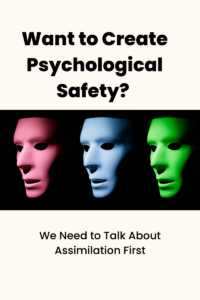 We seem to love buzzwords and yet can often lose sight of the deeper meaning. These words or phrases allow us to talk about an issue while managing to skirt the topic at hand. The idea of psychological safety is a present example, after which, on closer inspection, there remains much to discuss. While the intent behind psychological safety moves us towards a healthier organizational culture, how it rolls out and to whom may not be having the impact we desire. This example illustrates a moment in which intent and impact are out of alignment in many organizations.
We seem to love buzzwords and yet can often lose sight of the deeper meaning. These words or phrases allow us to talk about an issue while managing to skirt the topic at hand. The idea of psychological safety is a present example, after which, on closer inspection, there remains much to discuss. While the intent behind psychological safety moves us towards a healthier organizational culture, how it rolls out and to whom may not be having the impact we desire. This example illustrates a moment in which intent and impact are out of alignment in many organizations.
By and large, companies are moving towards more inclusive practices. Yet, what does it mean to be inclusive when we only see certain people? Our ability to foster truly inclusive environments requires the examination of policies and practices along with an organizational commitment to creating psychological safety and taking the further step to enable the conditions for individuals to surface their own needs.
To make psychological safety more concrete, Harvard Business School professor Amy Edmondson offers the following definition, “Psychological safety is a belief that one will not be punished or humiliated for speaking up with ideas, questions, concerns or mistakes.”
Applying this understanding of psychological safety, organizations need to examine how other variables intertwine with our ability to create a “safe space.” How do power, dominant cultural norms, and even the idea of wanting to be included factor into perceived and actual psychological safety? What assumptions are we making as we set about the task of creating psychological safety?
In addition to the reality that leadership teams and other rule-makers in the organization have the most significant access to psychological safety, there are other dynamics around power structures at play.
The pressure to assimilate is so prevalent in workplaces that it is often not recognized or is outright encouraged by the dominant culture within an organization. Consider how we define professionalism, concepts of time, or whether we operate from a cooperative or competitive lens. The ongoing message hidden under the surface is, “You are welcome to be yourself and speak your mind, within reason. We invite differences as long as you fit our culture.”
The failure to take a deeper look at cultural norms and expectations within a given organization presents a massive roadblock to advancing psychological safety. The idea that to get ahead, we need to play by a particular set of rules runs counterintuitive to creating inclusive environments. Yet, we continue to uphold these rules, further preventing individuals from advocating for changes that support their inclusion in organizations and, more importantly, their ability to do their best work.
The desire to fit in, not rock the boat, or climb the corporate ladder has conditioned many people to forgo psychological safety and hide in plain sight, or in other words, assimilate, which is consequently traumatizing. It leaves people feeling like they as individuals are not enough when it is the broader system that continues to lock people into this patterned behavior.
Assimilation can and does occur across various social identities. Organizations have become more well-versed (though not entirely) in what assimilation looks like from a racial, language, and gender perspective. Still, the pressure for individuals to secure economic stability, be seen as team players, or conform to the “way work gets done around here” limits our ability to dive deeper.
You may be thinking that’s good to know, but what does this look like in the context of everyday work environments? So, let’s pull back the curtain and look at a few examples.
Leila is an early-career professional in the television industry. She has had a few roles on the creative side and is seeking to get more into production. Lelia has been advised to begin the networking and interview process. She has a solid game plan in front of her yet, remains terrified of connecting with leads. Why? Lelia stutters when she gets nervous and worries she will not be able to communicate her skills and background effectively. When asked what might happen if she led the interview with the knowledge that she does have a stutter and would appreciate added patience, she responded, “You can do that?”
What would it take for individuals to move beyond the idea they have a deficit and need to be like everyone else?
Ron is a seasoned training professional. Several companies have actively sought after him for his high energy and personable way of connecting teams to the content. He has recently transitioned into a new role as Director of Learning. Ron knows that he can create strong content and deliver powerful workshops. Yet, he is frustrated by his tendency to spend time fussing over the written details and wonders if this will be seen as being slow to deliver at his new company. Why? Ron has dyslexia and is aware that he may overlook typos that others will easily catch, and he doesn’t want to be viewed as careless. When asked what percentage of his learning difference is on him to develop his own strategies and what percentage involves workplace accommodations, he shared, “It didn’t even occur to me that I could ask for support.”
How might a hyper organizational focus on perfectionism and timeliness impact our ability to be inclusive?
Aamir graduated top of his class and has just made partner at a prestigious law firm. He recognizes the importance of this moment in that there are very few Muslim attorneys in the United States. Aamir reflects on his success and what aspects of his cultural identity he may have given up along the way. He laments that he is heading to yet another business meeting, where deals will be made after hours over drinks. Why? Aamir notes, “I’m a Muslim; drinking is forbidden. I hate that I have to do this. I guess it’s back to sipping tonic for the evening.”
What might it look like to challenge the norms of when and where business takes place?
Tamika is a university professor who teaches in the honors program. She has earned a reputation for being tough but fair from her students. Tamika has set her sights on becoming chair of her department and reflects on the balance of cultural awareness and content knowledge needed. Recently she has encountered a growing body of students who have asked that their pronouns of they/them be used. Tamika is in complete support of this request yet struggles to use their correct pronouns. Why? “This isn’t a matter of understanding. This is the right thing to do to be supportive. And I am constantly battling years of being told as a Black woman, I need to speak correct English. My brain struggles to make the grammatical shift as it focuses on how people will view me as a professional.”
What might stop an employee from leaning into the “inclusive space” our company is building?
The names and identifying details have been modified for this writing. Still, these are genuine examples of the weighty norms placed on individuals who have learned, at best, how to cope with their expected assimilation.
I’ve said before that the work to shift organizational culture begins with its people, and it bears repeating. As individuals, we must be our own advocates, as teams, we must support one another, and as organizations, we must learn to use differences to uplift instead of silence.
